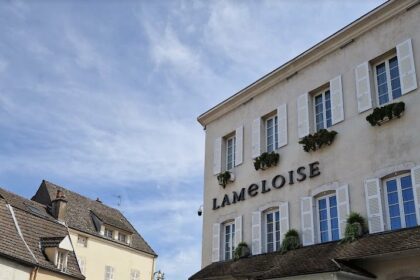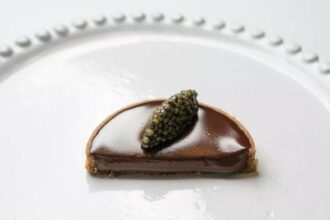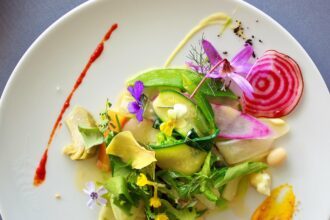Evaluation: 18.5/20
After closing his restaurant in Los Gatos due to a fire in the summer of 2014, David Kinch reopened Manresa in January 2015. Manresa has always been among the top five restaurants in the States where one can have a truly memorable meal. I have always found the early courses to be especially successful, but have been mostly unfazed by the meat course (except for the game pie). The restaurant economics in the States is such that top end restaurants cannot afford offering a whole fresh sweetbread or a large slice of turbot cooked in the bone etc. These are luxuries that you may take for granted not only in high end, but also in quite a few non-gastronomic restaurants in Europe. I usually derive more pleasure tasting three extremely well designed and executed courses at L’Ambroisie or Le Cinq under Le Squer than multi-course “creative tapas” degustation menus.
Manresa’s multi-course degustation menu is among the few exceptions for several reasons. Chef Kinch knows well how to build a progression throughout the five hour meal and the courses are not repetitive. He also does not adopt the trendy Scandinavian formula of composing multiple dishes around the same theme of the trio of “raw seafood-fermented green-dairy” and “lots of vegetable stocks”. His cooking is more complex, but remains focused and balanced. He cares about the quality of ingredients as much as anybody else and boasts a garden which is the source of his vegetables and salads, while he does not succumb to what I call “the imperialism of the garden”. That is, the bounty of the garden is taken into account in his meal planning to good effect, but does impose itself as a constraint. His cooking overall is light, but not intense. I am also partial to his offering of very good bread (especially the whole wheat) and exceptional quality butter with a grassy aroma. I had lamented in the past about the disappearance of the cheese tray, which, to me, is more important than desserts. However, it is now back and there are quite a few very good domestic cheeses on offer.

Our January 2nd meal at Manresa was certainly one of the best. Some taste bits are now signature: red pepper jellies and olive madeleines. The granola crisp is new. They are all good, but Kinch always pampers us with his beignets/cromesquis. This time it was a goat cheese and nasturtium beignet, and it was superb.
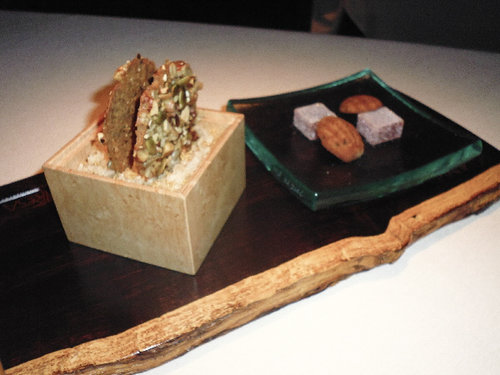
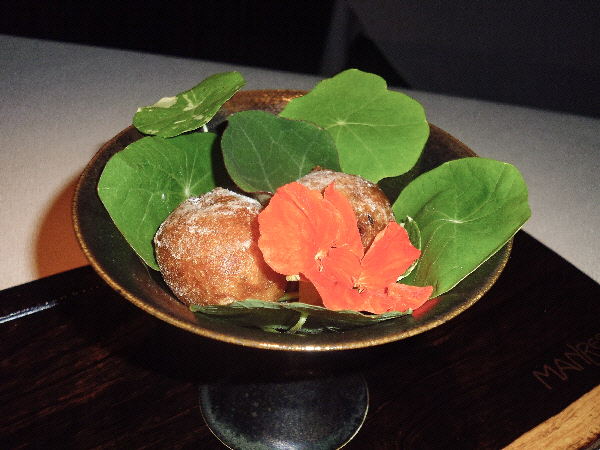
With the amuses we sipped Rose champagne from Lassaigne. This is quite a complex and pure rose with a floral, herbal nose. Lassaigne is one of the best small producers in champagne and this was the first time I have his rose and was really impressed.
Following the amuses, the menu consists of eight courses:
1. Seafood and caviar consommé
This dish is a masterpiece and one of the three favorites of the night. In this dish, very fresh Mendocino sea urchin, monkfish liver, and oysters swim in a pool of Kinch’s dashi (this level of dashi will make any Japanese chef proud) and the jus of fermented plum. Glaciale plant, which tastes like an oyster, decorates the dish. A good dollop of sevruga caviar from Israel blends extremely well and elevates this dish to the pantheon of the true expression of the iodine minerality of the rocky Pacific sea.
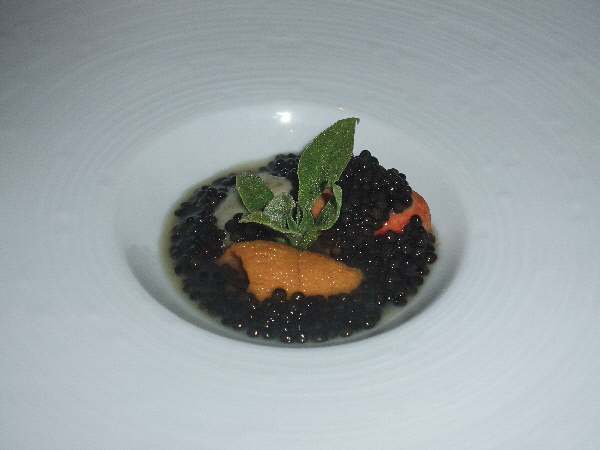
2. Turnips with dungeness crab, chrysanthemum
This dish included poached turnips and wekiwa tangelo. It is a cold and soothing Dungeness crab dish. The wine we have tried with these two dishes is one of my favorite Grosses Gewachs from Mosel: Clemens Busch Marienburg, Falkenlay from the excellent 2010 millesime. I described it in the wine section in Gastromondiale.
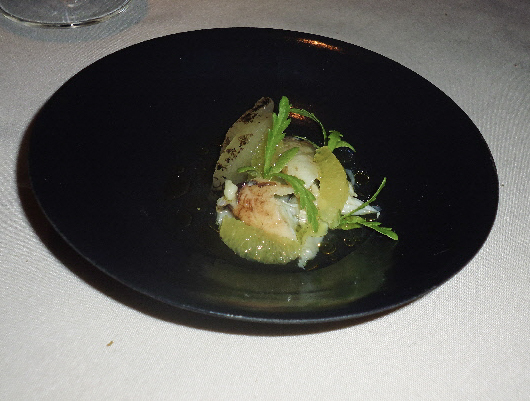
3. Scallop, fermented carrot and flowering coriander
This is a very good dish. The fermented carrots and yarrow added a sweet and earthy dimension, and the fresh coriander had layers of flavor and highlighted the sweetness of scallops. The combination worked. Kinch simply rolls the scallops around in a warm pan for about 20 seconds with olive oil and sea salt. This dish was paired with 2012 Domaine Leflaive Macon Verze. I had not tried this wine from Leflaive before. The well-structured lean body and citrus flavors worked well with the dish. A bigger oaky wine would have ruined the delicate taste of barely cooked scallops.
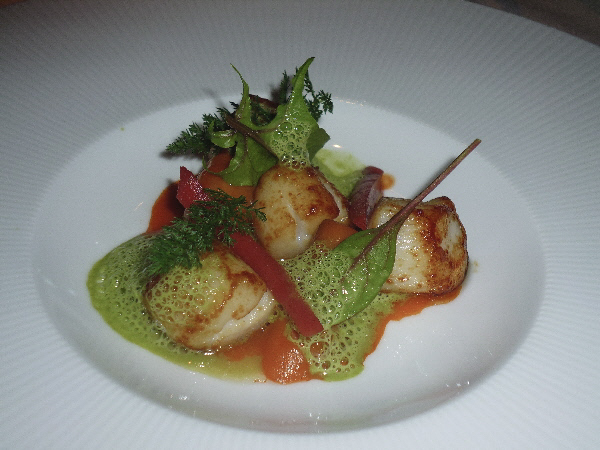
4. Into the vegetable garden
This is a fine course, but somehow I don’t think the vegetables in California possess the deep minerality one can find in the old continent (not unlike the wines). This said, the way Kinch binds different elements together with some root vegetables and potato “ash” is noteworthy. On the other hand, a touch more acidity, which may come from the addition of some tart herbs, should make a better balance.
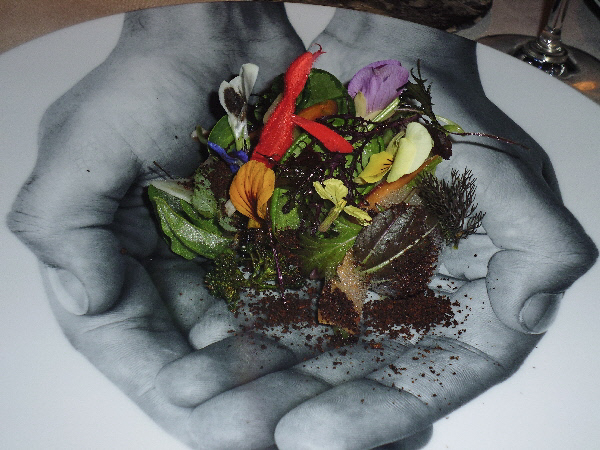
5. Black cod “norinade” and black truffle
This is an excellent dish. The black cod cannot be more fresh. It is certainly one of the best things from the sea since it is fatty and flakey. The chestnut balls rolled in truffle and topped with crunchy Brussels sprout leaves may be the equal of beignet with goat cheese and nasturtium. Kinch cooked the fish on the plancha and served it with a tapenade. But instead of olives, he used toasted nori. The sauce had onion, garlic, caper, olive oil and champagne vinegar and highlighted the sweetness of the black cod with the right touch of acidity. I wonder why various chefs prepare black cod in an overly sweet way, with honey-sake like marinades. Davide at Diver-XO prepares a civet from wild porc, discards the overcooked porc, and uses the civet with the black cod. I should say that Diver-XO’s black cod still is a reference point for me.
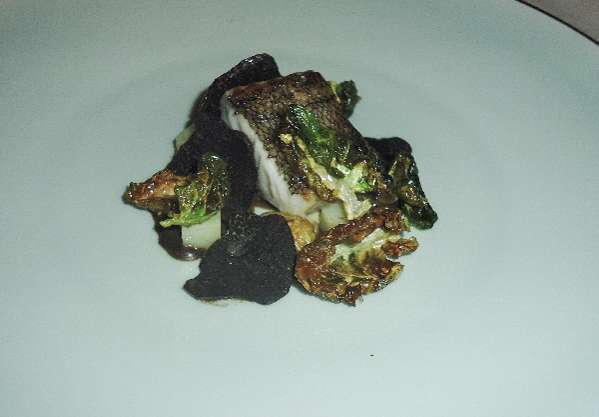
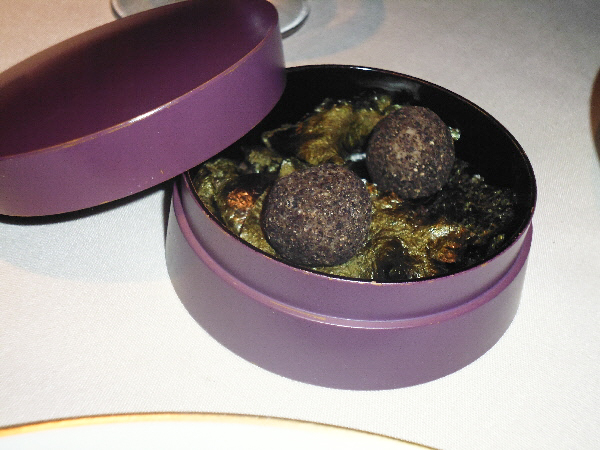
6. Abalone porridge and black truffle
This is the second dish that I found to be outstanding. The texture of the rice, which was cooked like an oatmeal, was amazing. It was creamy, but retained its texture and was not mushy. The abalone liver and porcini added depth and richness. Green onion, sesame, and yuzu were used in such a precise combination that they imparted aroma and acidity, and overall, this was a masterpiece. Very few Japanese chefs cook abalone as well as chef Kinch. This is a 20/20 dish.
7. Duck and sweet potato, dried persimmon, mustard fruit
Persimmon works so well with game. Kinch dry aged Liberty Farm duck, which I believe is a cross between a domestic species and Peking duck, for about a month and then he paired it with dried persimmon, mostarda, and yams cooked in a salt crust. The cooking of the duck breast was perfect, and the fatty part under the crisp skin was especially tasty. This was a delightful meat course.
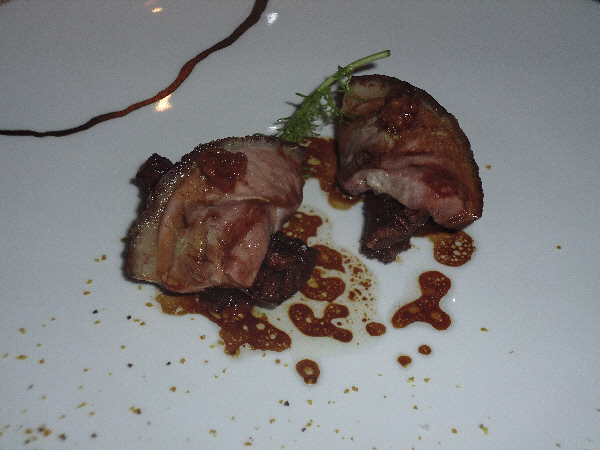
8. Beef roasted with bolets…beef broth, smoked lentil
The final savory course was by no means less impressive than the duck and certainly richer. The beef turned out to a thick piece of strip loin A5 Wagyu from Miyazaki. The wagyu was seared and then roasted very slowly for about 30 minutes in and out of the oven. It is hard to cook Wagyu so well and when everything comes together, the end result is sensual. Raw and cooked porcini mushrooms, served on the side, also impressed me. It was the first time that I have seen such high quality bolets in CA, on par with Piemonte and Dordogne. Chef Kinch followed the strip loin with a rich but clear broth, enriched by sprouted grains, toasted sesames, chanterelles, and smoked lentils. Overall, this two part course, was another masterpiece: earthy, complex and fulfilling. High end gastronomy and comfort food met for mutual benefit in this course.
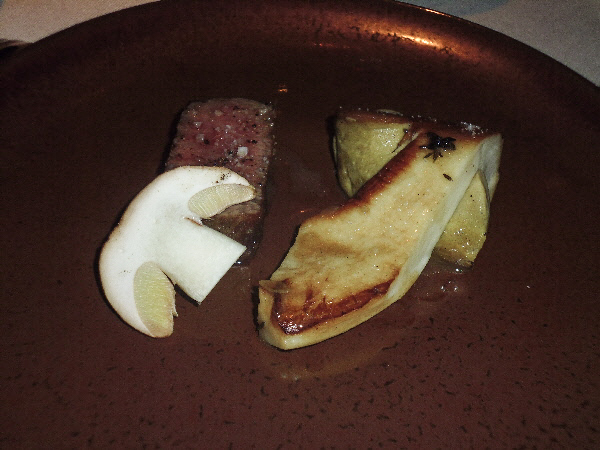
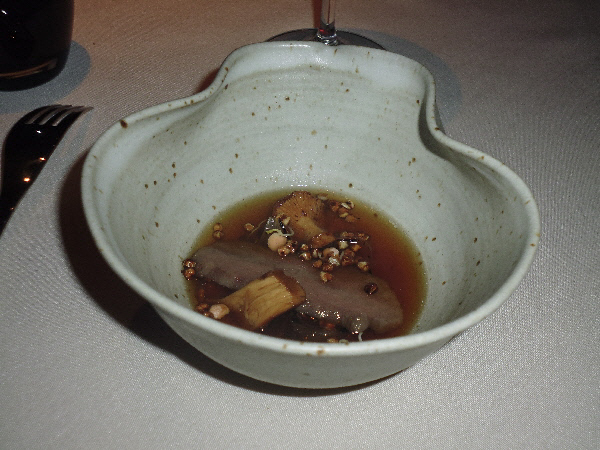
Then we had the cheese course. The highlight of it was the 2001 Parmigiano Reggiano. The whole wheel was purchased in Italy and at Manresa it was served with 65 year old balsamic vinegar. Obviously the cheese was dry, but had incredible depth. We also tried about eight domestic cheeses. I especially found three of them to be very good: a brie-like cow milk cheese from Pennsylvania, a camembert-like cheese wrapped in fig leaves and washed in whisky from Tennessee, and a runny and rich goat cheese washed in beer from Petaluma, California.
With the final few courses and the cheese, we had a 2010 Pierre Gelin Gevrey Chambertin, “Clos Prieur” 1er Cru. The wine is open and showing very well, but compared to the same bottle in France, this showed more oak. It may have been due to bottle shock.
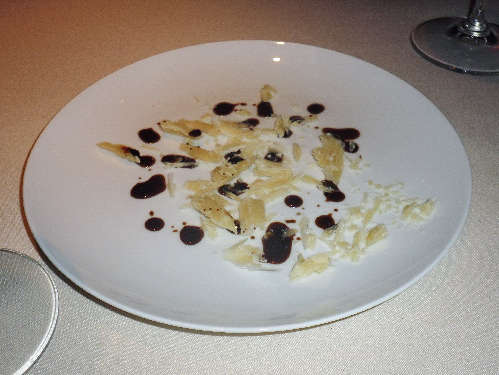
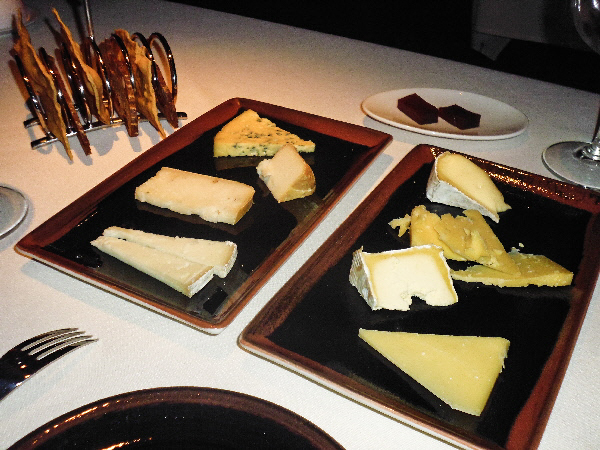
Finally we had three desserts:
- Quince and yogurt with hibiscus
- Apple and celery with green tea
- Pumpkin, chocolate and sherry vinegar
Desserts are modern at Manresa and follow prevailing trends. I liked them, particularly the “apple and celery with green tea”. However, I would rather have one memorable dessert, like the sable au chocolat at L’Ambroisie, the grapefruit dessert at Le Cinq under Le Squer, or the millefeuille at l’Arpege.
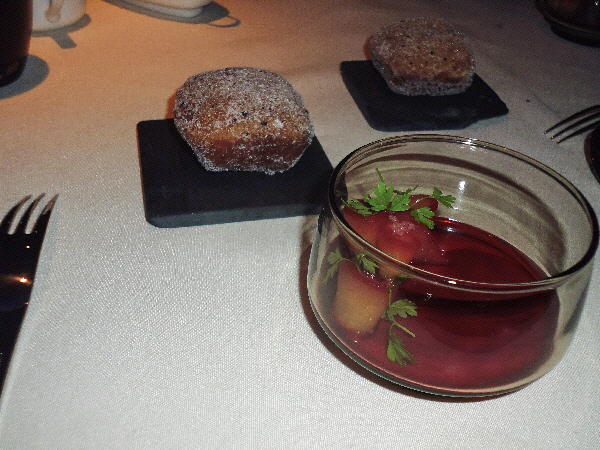
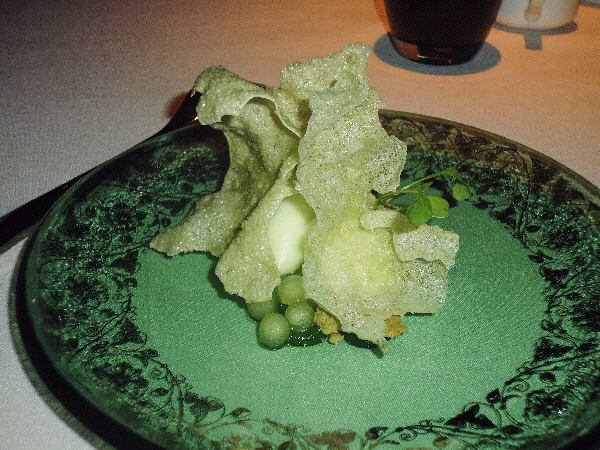
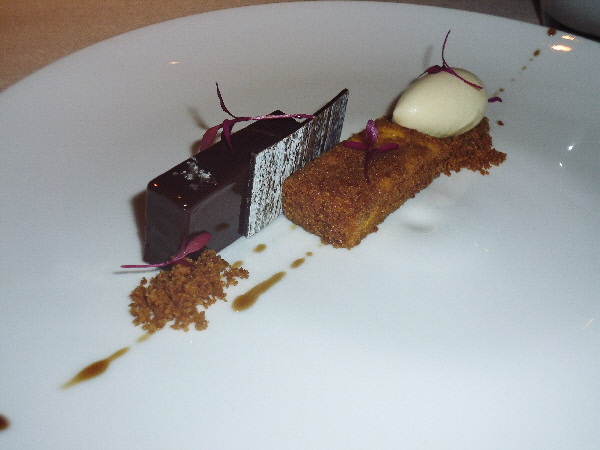
On the other hand, the petits fours are among the best I have seen anywhere, especially the remarkable macaroons.
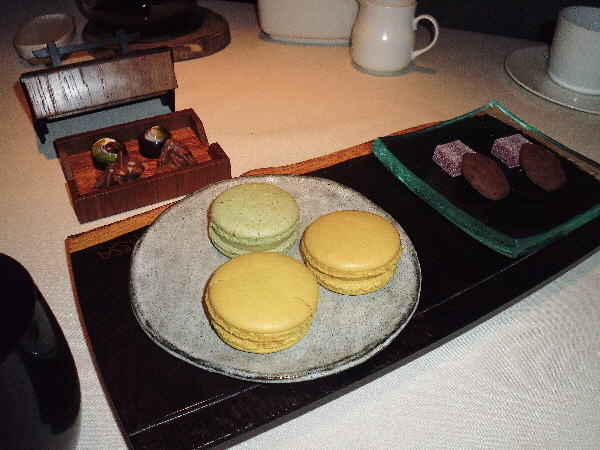
Overall it is hard to understand why the Michelin Guide is still not rewarding the third star to Manresa, as it is inarguably among one of the most exciting places to dine right now.* My hunch is that Kinch’s cooking is not pigeonhole-able, since it is neither Scandinavian trendy, nor too influenced by Japan, nor classical French. On the other hand, this is precisely what makes it so exciting, since Kinch is cooking what he likes, and he has very good taste and a good team around him to boot.
* Postscript: Manresa was awarded the third Michelin star after this review had been written.



